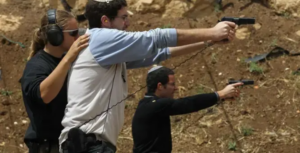Most modern militaries and law enforcement agencies train to employ their weapons from Condition 1. That is, magazine inserted, round in the chamber and safety engaged. All that is needed to get a round off is to aim, disengage the safety (or safeties), and press the trigger to its break. One country that does not follow this standard is Israel. The practice of carrying in Condition 3, or magazine inserted without a round in the chamber, is also known as “Israeli carry” for its popularity in the Jewish State. Israeli carry is taught as the handgun standard in both the Israel Defense Forces and Israel Police. However, the practice did not originate in Israel.
During the age of gunslingers in the Wild West, it was not uncommon for six-shot revolvers to be carried with only five rounds chambered in the cylinder. The revolver would be carried with the hammer down on the empty chamber to prevent sharp knocks or blows to the weapon from causing the hammer to fire a chambered cartridge unintentionally. This practice was even carried into the early 20th century with the advent of autoloading pistols.
Hidden rooms found in Egyptian pyramid may contain pharaoh’s riches, archaeologists say
The 1940 publication of FM 23-35, the War Department’s Basic Field Manual for the M1911 pistol, calls for carrying in both Conditions 3 and 1. “In campaign, when early use of the pistol is not foreseen, it should be carried with a fully loaded magazine in the socket, chamber empty, hammer down,” it reads. “When early use of the pistol is probable, it should be carried loaded and locked in the holster or hand.” Carrying with the magazine inserted, chamber empty, and hammer down is Condition 2.
Continue here: We Are The Mighty
Ask me anything
Explore related questions





